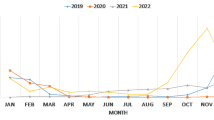Abstract
Background/purpose of the study
Although interventions to prevent mother-to-child transmission of HIV infection are being increasingly implemented as a part of national guideline, the prevalence of pediatric HIV remains high. There is remarkable increase in survival if HIV-infected children have access to early infant diagnosis (EID) and treatment.
Methods
The study was conducted in the Department of Obstetrics and Gynecology Medical College, Kolkata from July 2011 to February 2014 after obtaining approval from the institutional ethics committee. All the infants of HIV-positive mothers who came for EID between 6 weeks to 18 months of age during the study period were included in the study. A total number of 151 infants were included in the study and divided into Group A and B according to the time of first testing. It was a prospective observational longitudinal study. Data were collected from the EID register of PPTCT unit Medical College Kolkata. EID was done as laid out in the pediatric ART (anti-retroviral therapy) guidelines of the National AIDS Control Organization.
Results
Effectiveness of EID is judged by the corroboration of results at 6 week, 6 and 18 months. Comparing the results in group A, we found that 10.26, 8.41, and 7.29 % were positive at 6 weeks, 6 and 18 months, respectively, and with p value of 0.5828 the differences were not statistically significant. In group B, we observed that 47.06 and 45.45 % were positive at 6 and 18 months, respectively. Analysis revealed a p value of 0.9072 indicating no significant statistical difference between the results of testing in different periods. This reflects a good correlation between the 6 weeks, 6 and 18 months value, thus establishing the integrity of the EID.
Conclusion
Ultimate integrity of the PPTCT is judged by testing the child. EID is a novel procedure which aims at earlier diagnosis and initiation of treatment in the children.
Similar content being viewed by others
References
UNAIDS Report on the Global AIDS Epidemics 2012. www.unaids.org.
Guidelines for HIV care and treatment in infants and children NACO. 2006;3: 9–11.
Little K, Thorne C, Luo C, et al. Disease progression in children with vertically-acquired HIV infection in sub-Saharan Africa: Reviewing the need for HIV treatment. Curr HIV Res. 2007;5:139–53.
Patton JC, Sherman GG, Coovadia AH, et al. Ultrasensitive human immunodeficiency virus type 1 p24 antigen assay modified for use on dried whole-blood as a reliable, affordable test for infant diagnosis. Clin Vaccine Immunol. 2006;13:152–5.
Fischer A, Lejczak C, Lambert C, et al. Simple DNA extraction method for dried blood spots and comparison of two PCR assays for diagnosis of vertical human immunodeficiency virus type 1 transmission in Rwanda. J Clin Microbiol. 2004;42:16–20.
Torpey K, Mandala J, Kasonde P, et al. Analysis of HIV early infant diagnosis data to estimate rates of perinatal HIV transmission in Zambia. PLoS One. 2012;7(8):e42859. doi:10.1371/journal.pone.0042859 [Epub 2012 Aug 17].
Anoje C, Aiyenigba B, Suzuki C, et al. Reducing mother-to-child transmission of HIV: findings from an early infant diagnosis program in south-south region of Nigeria. BMC Public Health. 2012;12:184. doi:10.1186/1471-2458-12-184.
Lukong CS, Tshimwanga Ed, Mfuh YA. The role of PCR in early diagnosis of Human immunodeficiency virus infection in infants. Ann Afr med. 2013;12(4):232–5.
Acknowledgments
We are grateful to Dr. Pramit Ghosh Assistant Professor Community Medicine, Medical College Kolkata for guiding us in making the statistical analysis. Mr. Mrinmay Datta, Laboratory Technician PPTCT Medical College Kolkata for helping us in compiling the data.
Compliance with ethical requirements and Conflict of interest
All procedures followed were in accordance with the ethical standards of the responsible committee on human experimentation (institutional and national) and with the Helsinki Declaration of 1975, as revised in 2008 (5). Informed consent was obtained from all patients for being included in the study. Mariam Khanam, Sebanti Goswami & Partha Mukhopadhyay declare that they have no conflict of interest.
Author information
Authors and Affiliations
Corresponding author
Rights and permissions
About this article
Cite this article
Khanam, M., Goswami, S. & Mukhopadhyay, P. Effectiveness of Early Infant Diagnosis (EID) in Detecting the Serostatus of HIV-Exposed Infants and Children. J Obstet Gynecol India 65, 315–319 (2015). https://doi.org/10.1007/s13224-014-0632-2
Received:
Accepted:
Published:
Issue Date:
DOI: https://doi.org/10.1007/s13224-014-0632-2




